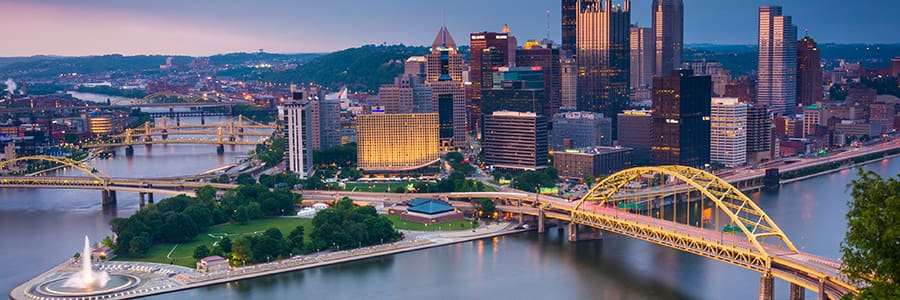
About The Ohio River
Formerly known as the Cherokee River, the Tennessee’s current name is believed to be derived from that of a Cherokee village, Tanasi.
The Ohio River, which streams westward from Pittsburgh, Pennsylvania, to Cairo, Illinois, is the largest tributary, by volume, of the Mississippi River. The 981-mile long river flows through or along the border of six states: Pennsylvania, Ohio, West Virginia, Kentucky, Indiana, and Ohio.
While the Mississippi may be more famous in steamboat history, it was actually on the Ohio River that the paddlewheel got its start, and the river is still a major shipping thoroughfare between major cities. A cruise along its busy waters, however, is surprisingly tranquil, offering an intimate look into life in the small towns of the American heartland.
American Cruise Lines and American Queen Steamboat Company sail the Ohio River each summer. Typically, cruisers can choose between to stretches of the river, from St. Louis to Cincinnati (visiting Missouri, Kentucky, and Indiana) or Cincinnati to Pittsburgh (calling at ports in Kentucky, Ohio, and West Virginia).
Ohio River Stats
Length: 981 miles
Depth: Maximum 167 feet
Source: Pittsburgh, Pennsylvania, USA at the confluence of the Allegheny and Monongahela Rivers
Mouth: Confluence with the Mississippi River near Cairo, Illinois, USA
Locks: 21
Countries: United States of America
Learn More About the Ohio River of the United States
The Ohio River is a prominent and historically significant waterway in the United States, flowing through several states in the Eastern and Midwestern regions of the country. Stretching approximately 981 miles (1,577 kilometers), it ranks as the largest tributary of the Mississippi River and has played a pivotal role in shaping the development of the American frontier, the industrial revolution, and the cultural mosaic of the regions it traverses. This vast and winding river, with its rich history and ecological importance, continues to be a vital part of the American landscape.
Geographical Features
The Ohio River originates at the confluence of the Allegheny and Monongahela Rivers in Pittsburgh, Pennsylvania, and flows westward, forming the border between the states of Ohio and West Virginia. It then meanders through the heartland of the United States, passing through or forming the borders of six additional states: Kentucky, Indiana, Illinois, and Missouri before ultimately joining the Mississippi River near Cairo, Illinois. The Ohio River’s watershed covers an extensive area, encompassing parts of 14 states. It drains nearly 204,000 square miles (529,000 square kilometers) of land, making it the third-largest drainage basin in the United States. The river’s size, combined with its intricate network of tributaries, contributes to its importance for transportation, agriculture, and ecological diversity.
Historical Significance
The Ohio River Valley has a deep and storied history that predates the arrival of European settlers. Native American cultures, including the Shawnee, Iroquois, and Mound Builders, thrived in this region long before European exploration and colonization began. The river was a vital source of sustenance, transportation, and trade for these indigenous peoples. European exploration and settlement in the Ohio River Valley began in the 17th century. French and British explorers and fur traders ventured into the region, establishing forts and trading posts. The struggle for control of the Ohio River Valley was a key factor in the French and Indian War (1754-1763) and the American Revolutionary War (1775-1783). The river played a crucial role in westward expansion, serving as a natural highway for pioneers and settlers. Cities like Cincinnati, Louisville, and Pittsburgh sprang up along its banks, serving as hubs for trade, industry, and culture. Steamboats became a common sight on the Ohio River in the early 19th century, revolutionizing transportation in the region and fostering economic growth.
Industrialization and Commerce
The industrial revolution in the 19th century brought further development to the Ohio River Valley. Factories, mills, and refineries proliferated along the riverbanks, making it a center of manufacturing and commerce. The river facilitated the transportation of raw materials, goods, and people, leading to the rapid growth of industries such as steel production, coal mining, and manufacturing. Pittsburgh, often referred to as the “Steel City,” became an industrial powerhouse due to its strategic location on the confluence of the Allegheny and Monongahela Rivers. The steel mills along these rivers produced vast quantities of steel, contributing significantly to the nation’s industrial might during the 20th century.
Environmental Importance
The Ohio River and its tributaries are home to a diverse range of wildlife and ecosystems. The river’s floodplains support a variety of plant and animal species, including freshwater mussels, fish, and waterfowl. However, the river’s ecological health has faced challenges due to industrial pollution, agricultural runoff, and urbanization. Efforts to address environmental issues in the Ohio River Basin have been ongoing. The Clean Water Act and other environmental regulations have helped improve water quality, and initiatives to restore and protect the river’s ecosystems have gained momentum.
Recreation and Tourism
Today, the Ohio River remains a popular destination for recreational activities such as boating, fishing, and camping. The river offers numerous opportunities for outdoor enthusiasts to explore its natural beauty and historical sites. The Ohio River Valley is also known for its scenic byways, historic landmarks, and cultural events.
Challenges and Conservation
Despite its historical significance and economic importance, the Ohio River faces several challenges, including pollution, habitat loss, and invasive species. Sustainable management practices and conservation efforts are essential to preserve this vital resource for future generations.
